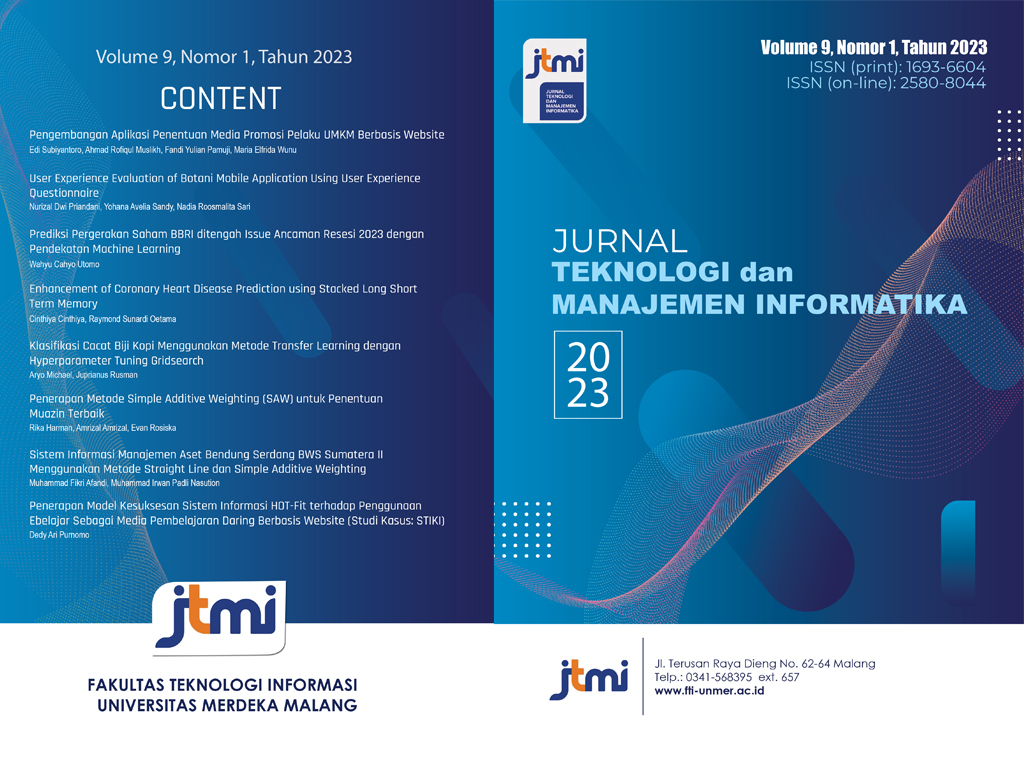Enhancement of Coronary Heart Disease Prediction using Stacked Long Short Term Memory
DOI:
https://doi.org/10.26905/jtmi.v9i1.9707Keywords:
Coronary Heart Disease, Stacked LSTM, Single LSTM, PredictionAbstract
The high incidence of death caused by coronary heart disease has become a global concern in the world of health, where patients with coronary heart disease are no longer only adults and the elderly, yet there are now so many cases of coronary heart disease experienced by underage patients. As a result, it is critical to be able to prevent and reduce the number of instances. One of them is the ability to predict a person's risk of coronary heart disease so that patients can be treated and provided early therapy. The risk of coronary heart disease will be predicted in this study utilizing Stacked long short-term memory algorithms. By appling this algorithm, the accuracy of 81.3% from previous study can be increased to 91.8% by this study.Â
Downloads
References
Ali, M. A., Kamraju, M., & Vani, M. (2017). Importance of health and fitness in life. Int Fed Comp Sci Sports, 41-45.
New Zealand Government. (2018).A Guide for Maintaining Health and Wellbeing. Health and safety. Govt. Nz. Retrieved from https://www.healthandsafety.govt.nz/assets/Documents/A_Guide_for_Maintaining_Health_and_Wellbeing.
Kumar, K. (2017). Importance of Healthy Life Style in Healthy Living. Juniper Online J. Public Heal, 2(5), from doi: 10.19080/jojph.2017.02.555596.
World Health Organization. (2021). Cardiovascular diseases (CVDs). Retrieved from https://www.who.int/news-room/fact-sheets/detail/cardiovascular-diseases-(vcds)
Wibisono, A. B. & Fahrurozi, A. (2019). Perbandingan Algoritma Klasifikasi Dalam Pengklasifikasian Data Penyakit Jantung Koroner. J. Ilm. Teknol. dan Rekayasa, 24(3), 161–170, from doi: 10.35760/tr.2019.v24i3.2393.
Rusdiana, T., Putriana, N. A., Sopyan, I. Gozali, D. and Husni, P. (2019). Pemberian Pemahaman Mengenai Sediaan herbal yang Berfungsi untuk Pemeliharaan Kesehatan jantung dan Ginjal di Desa Cibeusi, Sumedang, Jawa Barat. J. Pengabdi. Kpd. Masy, 4(6), 139–141.
Kompaspedia. (2021) Hari Jantung Sedunia: Pentingnya Pencegahan Penyakit Jantung. Retrieved from https://kompaspedia.kompas.id/baca/paparan-topik/hari-jantung-sedunia-pentingnya-pencegahan-penyakit-jantung.
NHS Service. (2021). Cardiovascular disease – NHS. Retrieved from https://www.nhs.uk/conditions/cardiovascular-disease.
Oscar Primadi. (2021). Penyakit Jantung Penyebab Kematian Tertinggi, Kemenkes Ingatkan CERDIK – Sehat Negerik. Retrieved from https://sehatnegeriku.kemkes.go.id/baca/umum/20170801/2521890/penyakit-jantung-penyebab-kematian-tertinggi-kemenkes-ingatkan-cerdik-2.
Themistocleous, I., Stefanakis, M. & Douda, H. T. (2017). Coronary Heart Disease Part I : Pathophysiology and Risk Factors. J. Phys. Act. Nutr. Rehabil., April, 167–175.
Hajar, R. (2017). Risk Factors for Coronary Artery Disease: Historical Perspectives. Heart Views, 18(3), 109-114, from doi: 10.4103/HEARTVIEWS.HEARTVIEWS_106_17.
De Ferranti, S. D., Steinberger, J., Ameduri, R., Baker, A., Gooding, H., Kelly, A. S., & Zaidi, A. N. (2019). Cardiovascular risk reduction in high-risk pediatric patients: a scientific statement from the American Heart Association. Circulation, 139(13), 603-634.
Healthy people. (2021). Heart Disease and Stroke Healthy People. Retrieved from https://www.healthypeople.gov/2020/topics-objectives/topic/heart-disease-and-stroke.
Riani, A., Susianto, Y., & Rahman, N. (2019). Implementasi Data Mining Untuk Memprediksi Penyakit Jantung Mengunakan Metode Naive Bayes. Journal of Innovation Information Technology and Application (JINITA), 1(01), 25-34.
Ramesh, T. R., Lilhore, U. K., Poongodi, M., Simaiya, S., Kaur, A., & Hamdi, M. (2022). Predictive analysis of heart diseases with machine learning approaches. Malaysian Journal of Computer Science, 132-148.
Javid, I., Alsaedi, A. K. Z., and Ghazali, R. (2020). “Enhanced accuracy of heart disease prediction using machine learning and recurrent neural networks ensemble majority voting method,†Int. J. Adv. Comput. Sci. Appl., 11(3), pp. 540–551, from doi: 10.14569/ijacsa.2020.0110369.
Liu, Y., Zhang, M., Fan, Z., & Chen, Y. (2020). Heart disease prediction based on random forest and LSTM. In 2020 2nd international conference on information technology and computer application (ITCA) IEEE, 630-635.
Sun, L., Wang, Y., He, J., Li, H., Peng, D., & Wang, Y. (2020). A stacked LSTM for atrial fibrillation prediction based on multivariate ECGs. Health information science and systems, 8, 1-7.
Bahad, P., Saxena, P., & Kamal, R. (2019). Fake news detection using bi-directional LSTM-recurrent neural network. Procedia Computer Science, 165, 74-82.
Sahar, A., & Han, D. (2018). An LSTM-based indoor positioning method using Wi-Fi signals. In Proceedings of the 2nd International Conference on Vision, Image and Signal Processing, 1-5.
Wei, C. C. (2020). Development of Stacked Long Short-Term Memory Neural Networks with Numerical Solutions for Wind Velocity Predictions. Adv. Meteorol., from doi: 10.1155/2020/5462040.
UCI Machine Learning Repository. (2021). Heart Disease Data Set. Retrieved from https://archive.ics.uci.edu/ml/datasets/heart+disease.
Ridzuan, F., & Zainon, W. M. N. W. (2019). A review of data cleansing methods for big data. Procedia Computer Science, 161, 731-738.
Srivastava, N., Hinton, G., Krizhevsky, A., Sutskever, I., and Salakhutdinov, R. (2014). Dropout: A Simple Way to Prevent Neural Networks from Overfitting. Journal of Machine Learning Research, 15 (56): 1929–1958.
Liu, P., Sun, X., Han, Y., He, Z., Zhang, W., & Wu, C. (2022). Arrhythmia classification of LSTM autoencoder based on time series anomaly detection. Biomedical Signal Processing and Control, 71, 103228.
Liu, F., Cai, M., Wang, L., & Lu, Y. (2019). An ensemble model based on adaptive noise reducer and over-fitting prevention LSTM for multivariate time series forecasting. IEEE Access, 7, 26102-26115.
Hansun, S., Charles, V., & Gherman, T. (2023). The role of the mass vaccination program in combating the COVID-19 pandemic: An LSTM-based analysis of COVID-19 confirmed cases. Heliyon, 9(3).
Hansun, S., & Young, J. C. (2021). Predicting LQ45 financial sector indices using RNN-LSTM. Journal of Big Data, 8(1), 1-13.
Yoon, T., & Kang, D. (2023). Multi-Modal Stacking Ensemble for the Diagnosis of Cardiovascular Diseases. Journal of Personalized Medicine, 13(2).
Downloads
Additional Files
Published
Issue
Section
License
Authors who publish with this journal agree to the following terms:
(1)Â Copyright of the published articles will be transferred to the journal as the publisher of the manuscripts. Therefore, the author confirms that the copyright has been managed by the journal.
(2) Publisher of JTMI: Jurnal Teknologi dan Manajemen Informatika is University of Merdeka Malang.
(3) The copyright follows Creative Commons Attribution–ShareAlike License (CC BY SA): This license allows to Share — copy and redistribute the material in any medium or format, Adapt — remix, transform, and build upon the material, for any purpose, even commercially.




